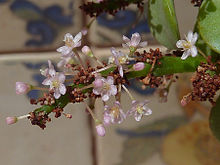Portulacaria afra
| Portulacaria afra | |
|---|---|
 |
|
 |
|
| Scientific classification | |
| Kingdom: | Plantae |
| Clade: | Angiosperms |
| Clade: | Eudicots |
| Order: | Caryophyllales |
| Family: | Didiereaceae |
| Genus: | Portulacaria |
| Species: | P. afra |
| Binomial name | |
|
Portulacaria afra Jacq. |
|
Portulacaria afra (known as elephant bush, dwarf jade plant, porkbush and spekboom in Afrikaans) is a small-leaved succulent plant found in South Africa.
It is a soft-wooded, semi-evergreen upright shrub or small tree, usually 2.5–4.5 metres (8–15 ft) tall. Similar in appearance to the unrelated "jade plant" Crassula ovata (family Crassulaceae), P. afra has smaller and rounder pads and more compact growth (shorter internodal spaces, down to 1.5 mm). It is much hardier, faster growing, more loosely branched, and has more limber tapering branches than Crassula once established.
Within the genus Portulacaria, it has been shown to be an outlier, relatively unrelated to the other species in the genus, which are all restricted to small ranges in the arid far west of southern Africa.
It is very widespread in the east of South Africa (including Swaziland). In this moist climate, it is relatively rare, and tends to favour dryer rocky outcrops and slopes.
It is also found in much denser numbers in the dryer southern Cape. Here it occurs from the "Little Karoo" of the Western Cape, eastwards up until the thicket vegetation of the Eastern Cape. Spekboom is found most prolifically in the Albany thickets, a woodland ecoregion, which locally is often called noorsveld, after the high number of succulent Euphorbia species, which are often called noors plants.
In the wilds of South Africa, large plants do survive the winter frosts by growing dense enough to provide their own natural cover. Drought-tolerant and fire-resistant, it will endure desert sun and heat once established, which the jade plant will not. Cuttings root very easily in most potting media.
...
Wikipedia
